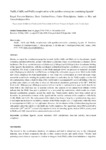Zn(II), Cd(II) and Pb(II) complexation with pyridinecarboxylate containing ligands

Use this link to cite
http://hdl.handle.net/2183/19646Collections
- Investigación (FCIE) [1227]
Metadata
Show full item recordTitle
Zn(II), Cd(II) and Pb(II) complexation with pyridinecarboxylate containing ligandsAuthor(s)
Date
2008-09-09Citation
Zn(II), Cd(II) and Pb(II) complexation with pyridinecarboxylate containing ligands. R. Ferreirós-Martínez, D. Esteban-Gómez, C. Platas-Iglesias, A. de Blas and T. Rodríguez-Blas, Dalt. Trans., 2008, 5754–5765.
Abstract
[Abstract] Herein, we report the coordination properties towards Zn(II), Cd(II) and Pb(II) of two hexadentate ligands containing pyridinecarboxylate groups with ethane-1,2-diamine (bcpe) or cyclohexane-1,2-diamine (bcpc) backbones. The X-ray crystal structures of [Zn(bcpe)], [Cd(bcpe)] and [Cd(bcpc)] show hexadentate binding of the ligand to the metal ions, with the coordination polyhedron being best described as a severely distorted octahedron. The X-ray crystal structure of the Pb(II) analogue shows the presence of tetrameric structural units [Pb4(bcpe)4] in which the four Pb(II) ions are bridged by carboxylate oxygen atoms. While in the Zn(II) and Cd(II) complexes the bcpe ligand adopts a twist–wrap (tw) conformation in which the ligand wraps around the metal ion by twisting the pyridyl units relative to each other, for the Pb(II) complex a twist–fold (tf) conformation, where a slight twisting of the pyridyl units is accompanied by an overall folding of the two pyridine units relative to each other is observed. Theoretical calculations performed at the DFT (B3LYP) level on the [Pb(bcpe)] and [Pb(bcpc)] systems indicate that the tf conformation is more stable than the tw form both in the solid state and in aqueous solution. The analysis of the natural bond orbitals (NBOs) indicate that the Pb(II) lone-pair is polarized by a substantial 6p contribution, which results in a hemi-directed coordination geometry around the metal ion. Potentiometric studies have been carried out to determine the protonation constants of the ligands and the stability constants of the complexes with Zn(II), Cd(II), Pb(II) and Ca(II). The replacement of the ethylene backbone of bcpe by a cyclohexylene ring causes a very important increase in the stability constant of the Pb(II) complex (ca. 2.3 logK units), while this effect is less important for Cd(II) (ca. 1.4 logK units). However, the introduction of the cyclohexylene ring does not substantially affect the stability of the Zn(II) and Ca(II) complexes. The ligand bcpc shows Pb/Ca and Cd/Ca selectivities [108.9 and 109.8, respectively] superior to those of extracting agents, such as EDTA, already used in Pb(II) and Cd(II) removal from contaminated water and soils.
Keywords
Picolinate ligands
Crystal structures
DFT calculations
Lone-pair activity
Heavy-metal complexes
Crystal structures
DFT calculations
Lone-pair activity
Heavy-metal complexes
Editor version
ISSN
1477-9226
1477-9234
1477-9234





